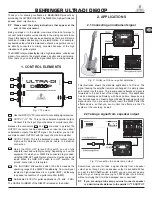
Assembler
5-13
Code Development Tools
#IF expression: The start of a conditional assembly structure expression is an
arithmetic expression that can contain symbols. Caution: since conditional
assembly is resolved during the first pass of the assembler, no forward
referenced symbols should be used in a conditional assembly
expression. If an expression is TRUE (non zero), then the lines following this
directive are assembled until a #ELSE or a #ENDIF directive is encountered.
If an expression is FALSE (equal to zero), then all input lines are skipped until
a #ELSE or a #ENDIF directive is encountered. If a #ELSE directive is
encountered first, all lines following it are assembled, until a #ENDIF directive
is found.
Example:
#IF expression
; do something here
#ELSE
; do other things here
#ENDIF
#IFDEF symbol: Start of a conditional assembly structure. If the symbol has been
defined (either with a #DEFINE directive or an EQU directive) then the lines
following this directive are assembled until a #ELSE or a #ENDIF directive are
encountered. If symbol has not been defined, then all input lines are skipped
until a #ELSE or a #ENDIF directive is encountered. If a #ELSE directive is
encountered first, all lines following it are assembled, until a #ENDIF directive
is found.
#IFNDEF: Start of a conditional assembly structure. If symbol has NOT been defined
then the lines following this directive are assembled until a #ELSE or a #ENDIF
directive is encountered. If symbol has been defined (either with a #DEFINE
directive or an EQU directive), then all input lines are skipped until a #ELSE
or a #ENDIF directive are encountered. If a #ELSE directive is encountered
first, all lines following it are assembled, until a #ENDIF directive is found.
Summary of Contents for MSP50C6xx
Page 6: ...vi...
Page 14: ...xiv...
Page 24: ...1 10...
Page 296: ...Instruction Set Summay 4 210 Assembly Language Instructions...
Page 366: ...6 12...
















































